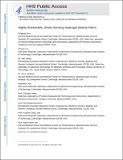Highly Stretchable, Strain Sensing Hydrogel Optical Fibers
Author(s)
Guo, Jingjing; Liu, Xinyue; Jiang, Nan; Yetisen, Ali K.; Yuk, Hyunwoo; Yang, Changxi; Khademhosseini, Ali; Zhao, Xuanhe; Yun, Seok-Hyun; ... Show more Show less
Downloadnihms832920.pdf (965.2Kb)
OPEN_ACCESS_POLICY
Open Access Policy
Creative Commons Attribution-Noncommercial-Share Alike
Terms of use
Metadata
Show full item recordAbstract
The design and fabrication of highly stretchable and tough optical fibers made of optically optimized alginate-polyacrylamide hydrogel materials in a core/clad step-index structure was reported. To characterize the swelling properties, hydrogels were fabricated at different AAm concentrations, and their weights were measured immediately after crosslinking (pre-swelling state) and later after they have been immersed in Dulbecco's Modified Eagle Medium (DMEM) at 37°C and 5% CO2 for 3 d. The weights of postswelling samples increased by a factor of 1.53 1.62 with respect to the preswelling states almost independent of the AAM concentration. First, the core was fabricated by injecting a Ca2+ containing alginate-polyacrylamide precursor solution into a platinum-cured silicone tube mold with a syringe and curing the solution by UV light irradiation. After polymerization, the core was extracted from the mold by swelling the tube in dichloromethane for 20 min. Next, the clad was formed on the core fiber by a two-step dip-coating method. The ionic cross-linking of alginate chains by Ca2+ results in high viscosity and makes it hard to dip the core and coat a cladding layer on it. Using various tube molds of different inner diameters and varying the clad dipping time, hydrogel fibers with various core and clad diameters were fabricated. The diameter of the crosslinked core when taken out of the mold is identical to the inner diameter of the mold (pre-swelling), but it increases by a factor of 1.5 1.7 at fully swollen states. The strain accuracy was ±1% in short- and long-term measurements in the moist environment, but the readout was sensitive to the variation of swelling state of the hydrogels. Keywords: absorbance spectroscopy; fiber optics; hydrogels; strain sensing
Date issued
2016-06Department
Massachusetts Institute of Technology. Department of Mechanical EngineeringJournal
Advanced Materials
Publisher
Wiley Blackwell
Citation
Guo, Jingjing et al. “Highly Stretchable, Strain Sensing Hydrogel Optical Fibers.” Advanced Materials 28, 46 (October 2016): 10244–10249 © 2016 WILEY‐VCH Verlag GmbH & Co. KGaA, Weinheim
Version: Author's final manuscript
ISSN
0935-9648
1521-4095